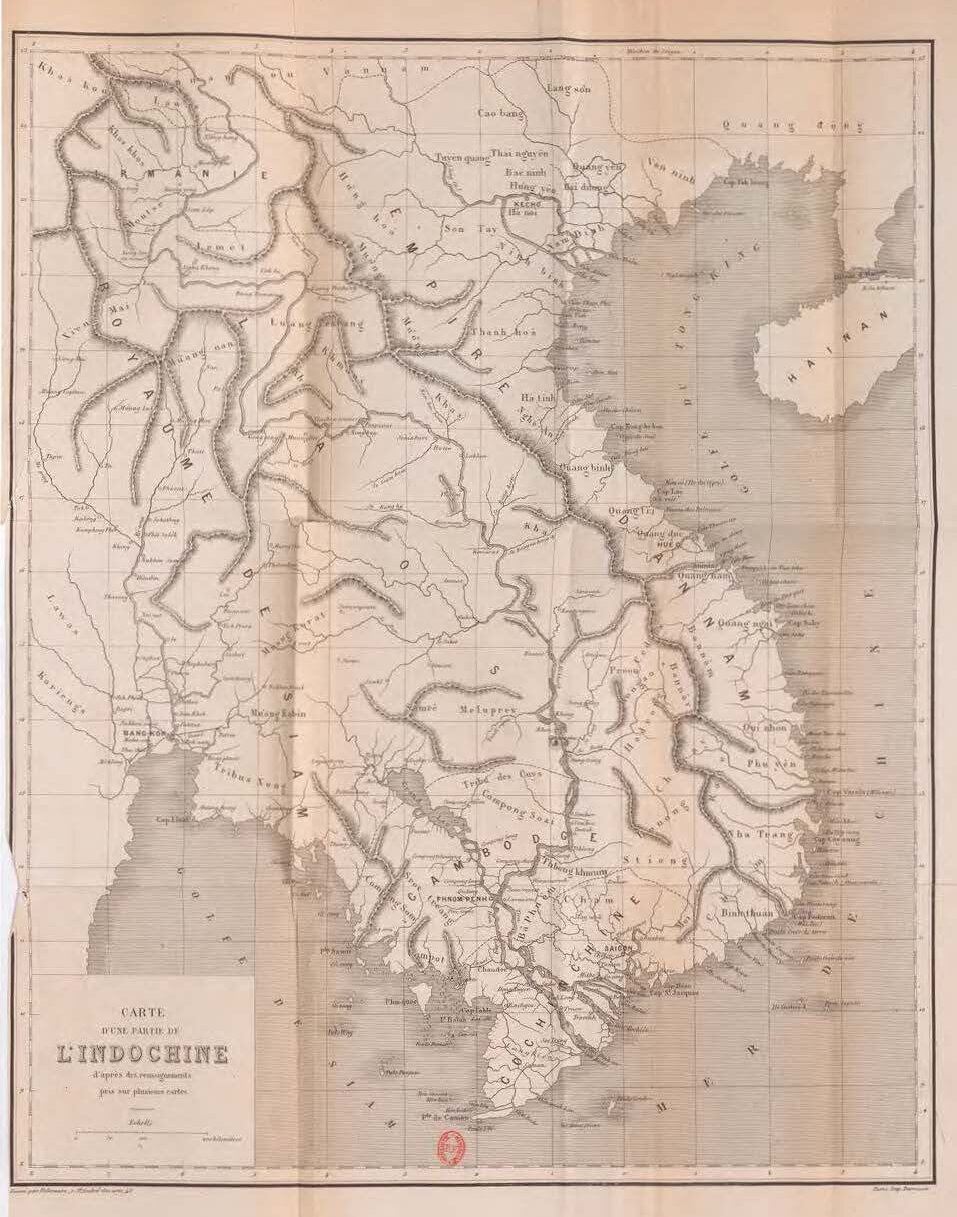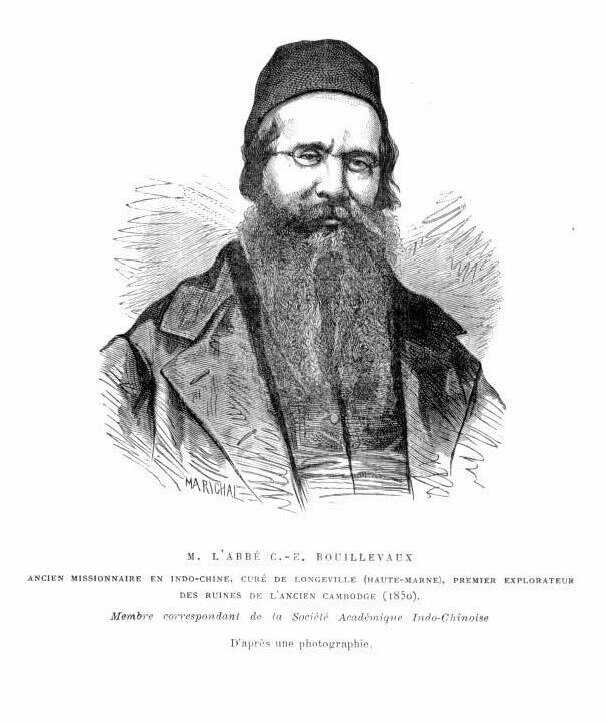L'Annam et le Cambodge, Voyages et récits historiques
by C.-E. Bouillevaux
With a map of "Indochina", an expanded version of Pere Bouillevaux's 1858 book.

- Format
- on-demand books
- Publisher
- Victor Palmé, Paris
- Edition
- Victor Palmé, Paris | ebook via gallica.bnf.fr
- Published
- 1874
- Author
- C.-E. Bouillevaux
- Pages
- 552
- Language
- French
Almost twenty years later, the indefatigable French missionary revisited the travelogue in which he had described Angkor a few decades before Henri Mouhot and John Thomson. In the meantime, several studies on Khmer art and the geography of Indochina had been published, and Bouillevaux referred to the works of James Fergusson or Francis Garnier (but not Mouhot’s) in this expanded edition.
A expanded description of Angkor
“Au centre de ces galeries, et beaucoup plus élevée qu’elles, se dresse la forteresse de pierres, comme on l’appelle dans certains manuscrits, qu’est Angcor-vot. A chaque angle de ce gigantesque et splendide édifice se dresse une belle tour ayant la forme d’une tiare immense et magnifique. Au milieu se dresse une tour de la meme forme, mais plus haute que les autres: elle a 56 mètres au-dessus du niveau de la chaussée. De grandes galeries dont les murs sont décorés de de sculptures réunissent toutes ces tours. On monte à la pagode par quatre escaliers monumentaux. Cet edifice est bati presque entièrement en pierre de grès, admirablement fouillées par les artistes. Il faut dire cependant que ces habiles ouvriers n’entendaient rien a sculpter la figure humaine: leurs personnages sont presque toujours grotesques.”(p132) [“In the center of these galleries, and much taller than the latter, rises the stone fortress as it is called in certain manuscripts, Angcor-vot. At each one of the corners of this vast and splendid building are beautiful towers in the form of a tiara. In the middle, another tower equally shaped, but much taller as it rises 56 meters above the level of the pathway. All towers are connected by great galleries decorated with sculptures. One reaches the pagoda through monumental stairways. The building is almost entirely made of sandstone blocks, admirably carved by the artists. However, one must say that the skillful workers were inept at sculpting the human shape, since all their figures are almost always grotesque.” [the devout Catholic was apparently immune to the graceful charm of the Angkorean apsaras]]
Bouillevaux’s map of Indochina
Tags: Annam, Chams, Cham, Siam, Indochina, Angkor Wat, Khmer dynasties, Vietnamese dynasties, architecture, sculpture, French travelers, French missionaries
About the Author

C.-E. Bouillevaux
Père Charles-Émile Bouillevaux (1 Apr. 1823, Montier-en-Der, France — 6 Jan. 1913, Montier-en-Der) was a French missionary and explorer who visited Angkor in December 1850 but waited until 1878 to publish an extensive account of his visit, Ma visite aux ruines cambodgiennes en 1850 (Mémoires de la Société académique indochinoise, T. 1), long after the popular interest encountered by Henri Mouhot’s description.
Reaching Cochinchina in 1849, he saw Angkor in 1850 and, a few months later, stayed with the Pnong (Penongs in the French transliteration) people in Northeastern Cambodia, traveled from Sambor to Ha-Tien in nine days, then stayed in Laos from 1853 to 1855, came back briefly to Cambodia in 1855 (Battambang). Following a brief return to Europe, he served as abbot of Choquan from 1867 to 1873. He was with the Société des Missions étrangeres, a French apostolic organization which had started to send missions to the Far East as early as 1661 (to Siam) and 1664 (to Cochinchina).
Contributing several articles to the periodical Courrier de Saigon, Bouillevaux published a Map of Cambodia, two relations of his travels in ‘Indochina’ (Voyages dans l’Indochine, 1848 – 1856 (Paris, Victor Palmé, 1858) and L’Annam et le Cambodge, Voyages et notices historiques (Paris, Victor Palmé, 1874).
Many historians of Angkor, including B.P. Groslier, have argued that Pere Bouillevaux did not immediately realize the significance of Angkor, even if he visited the Khmer ruins ten years before Henri Mouhot or John Thomson. George Coedès, however, granted him the privilege to be the first Western visitor of Angkor in the 19th century. As for Casimir-Edmee de Croizier, he wrote quite peremptorily in his 1878 brochure Les explorateurs du Cambodge: “La priorité pour l’exploration des monuments de l’ancien Cambodge lui appartient donc d’une façon incontestable, et son nom doit primer celui de tous les autres voyageurs.” [“The priority in the exploration of the monuments of ancient Cambodia irrefutably belongs to him, and his name must take precedence over that of all other travelers.”
This portrait completed Bouillevaux’s paper ‘Ma visite aux ruines cambodgiennes en 1850’ [‘My visit to the Ruins of Cambodia in 1850’] in Mémoires de la Société académique de l’Indochine, t. I, 1877. The caption in French reads: “Abbot C.E. Bouillevaux, former missionary in Indochina, abbot of Longueville (Haute-Marne), first explorer of the ruines of Ancient Cambodia (1850).”


